Through many of my recipes and talks of food with my Auntie Brenda, she never fails to mention that her favorite pancit dish is Miki Bihon. During our last conversation, she reminded me of all the fantastic cooking that my grandfather used to easily whip up, between dancing or exercising (usually one in the same). She also reminisced about the flawless dishes of those in our family who have passed away. It got me thinking again about the days of house parties or bigger parties at community halls. I was also reminded of one of the many reasons that I come up with and write these blogs and recipes. My hopes are that I give everyone the guidance or confidence to carry on the Filipino pride and spirit, no matter what your level of kitchen expertise is. This Easy Pancit Miki Bihon recipe is one of them.
This recipe is for all of our loved ones who have passed but have paved the way for us to do and cook great things. I love and miss you all!
Easy Recipes
Let’s agree to take “Easy Recipes” with a grain of salt, or should I say “grain of rice”. From one kitchen to another, there are so many factors or variables that will make a dish easy or difficult to accomplish. That is why I enjoy writing these blog portions before recipes. I get an opportunity to give you as many unconscious habits or techniques that play a huge role in kitchen success. Many of these tips don’t reveal themselves in typical recipes that you can print off from the net.
In addition, I like to write up or create some of my recipes with the most unexperienced cook behind the burner. Some of m recipes might not reflect the traditional ingredients or techniques because I want to give everyone a chance to learn by trying. Sure there might be mistakes or huge disasters, but it’s how we learn.
Bihon Extension
If you have already made my Delicious Pancit Bihon recipe, then you are way ahead in the game. The Easy Pancit Miki Bihon recipe is in fact easy because were are adding just a couple more ingredients and steps. The prep and process for the chicken and veggies will remain the same.
Miki Noodles
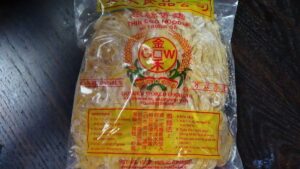
Of course, the major difference between the two dishes is the addition of the Miki noodles. Where Bihon noodles are thinner, rice noodles, Miki will be thicker, egg noodles. The contrast of the two noodles, with each bite, is certainly satisfying. You can buy Miki noodles dry or fresh, in the refrigerated section at your local Asian Market. I have yet to try it with the dry noodles but I would imagine that it would still taste great!
If you don’t see a fresh Filipino brand, don’t worry. Chinese Egg Noodles are awesome too. Here is the brand that my local market carries:

Also, before you rip open the package and throw it in the garbage, be sure to read and follow the companies cooking instructions. For my variety, it only consists of a 10 second boil. Now imagine if you did not see that. I am pretty sure that they end up boiling in the pot for longer than 10 seconds but if you overcook fresh egg noodles, they can become clumpy and mushy. At this point, it is okay if you undercook your fresh noodles. They will continue to cook when you add it them to the rest of the ingredients.
I usually have pretty good luck with separating the noodles first, before adding them into the pot. Use a bigger pot to cook your noodles too. When they cook they will release their starchiness. If you have a bigger pot, your noodles won’t be bathing in a pot of starchy water. In addition to separating the noodles ahead of time, I have also heard that some people give them a quick rinse to wash off some of that starch, but I have yet to try that.
Once boiled, I give them a cold water rinse to stop the cooking process. To keep them loose, I kind of comb or massage my fingers through the noodles as the cold water runs on them.
When leaving them to drain, be sure to push the noodles to the sides of your colander/strainer. The water will collect in the middle as it drains, so you want to keep them from sitting in this collection.
Shrimp
Forget me, my kids are absolutely in love with shrimp, especially with noodles. As far as size goes, that is totally up to you. Just be sure to cut your work down by getting them raw, peeled, deveined a tail off. Medium sized shrimp works well with this dish and frozen is fine. You don’t have to break the bank, going for fresh shrimp. Also remember that part of your prep work is to defrost the shrimp. Luckily this does not take too long. It can be simply done by placing them in a strainer, giving them a quick rinse, with cold water, and just let it sit until you are ready to cook.
Prep Work
Start off by getting 5 cups of boing water ready to cook your chicken and make your broth. You will only need 3 cups of the broth for later. The rest can be used or another dish.
Wash and cut all of your vegetables. You can keep it basic with carrots, snow peas and cabbage but please feel free to add any of your favorites. I like to julienne cut (long, thin strips) my veggies for this because it complements the structure of the noodles very well. Onions don’t have to be julienned, since they get sautéed and reduce in size by the time you are ready to serve.
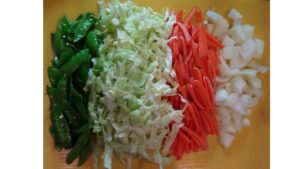
Speaking of that complementary texture, I like hand shredding my chicken for pancit dishes.
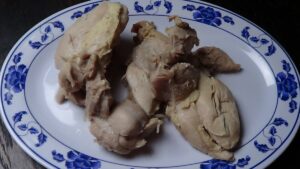
As for the noodles, they will need some prep work too. The last thing that you want is for your onions to be sautéing and you don’t have other ingredients ready. So be sure that everything is ready to go before you start cooking up the main dish.
Refer to the directions on your Bihon package. Most varieties will consist of a 10 – 15 minute soaking before cooking. After soaking, I like giving them a quick rinse as well.
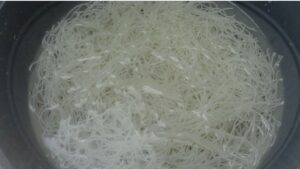
Your Miki noodles will need a quick boil if you bought them fresh. I like bringing my water to a boil first. Once I add the separated noodles, I mix them with chopstick in a manner that keeps them from burning to the bottom but also carefully continue to loosen them up. Keep in mind that they are fresh noodles and they will break apart easier than the hard dry noodles that you may have experience with.
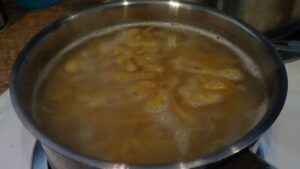
After the quick boil, run them under cold water to stop the cooking process. As they rinse, continue to gently loosen them with your hand, keeping them from clumping together. Allow time for them to drain well.
Easy Pancit Miki Bihon Picture Guide
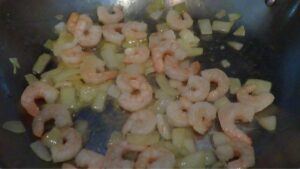
Preheat pan on a medium high heat, add oil and sauté onions. Add shrimp and stir until cooked. Shrimp will become pink and have a more solid texture when cooked. Remove shrimp from pan when cooked, but leave the onions.
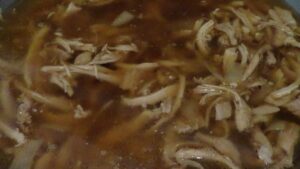
Add shredded chicken, soy sauce, garlic and 3 cups of the chicken broth to the pan. Bring to a simmer on a medium to medium-high heat and stir.
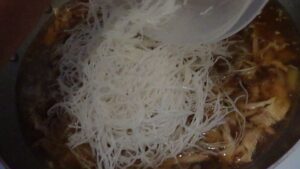
Add soaked Bihon noodles and reduce heat to medium. Stir regularly to prevent noodles from burning to the bottom of the pan. The noodles will begin to soak up the broth from the pan.
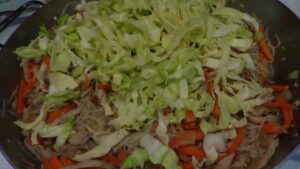
Before all of the broth is soaked up, mix in the cabbage and carrots. Continue to stir well.
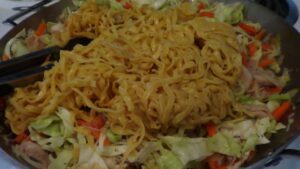
Once the broth is gone, add the Miki noodles, shrimp and Patis. Mix well, but in a fashion that preserves the long strands of Miki noodles. Add salt and pepper.
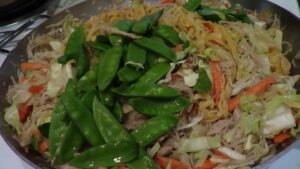
To enjoy the nice crunch, I like adding the snow peas last. These don’t have to be completely cooked to eat.
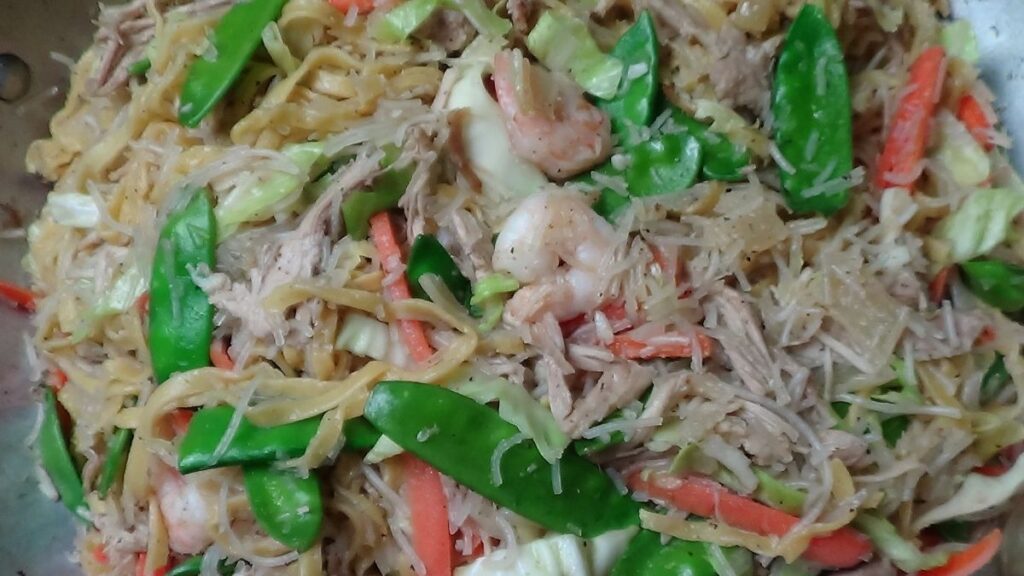
Enjoy and I hope that you didn’t forget to cook rice.
Masayang Pagluluto!
Kain na tayo!
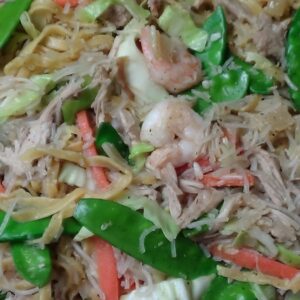
Easy Pancit Miki Bihon
Ingredients
- 3 lbs boneless skinless chicken thighs
- 1 Tbs salt
- 6 cup water
- 1 med onion chopped
- 2 cup carrots julienne cut
- 6 cloves garlic minced
- 3 cups snow peas ends trimmed off
- ¼ head cabbage
- 16 oz package of Bihon noodles
- 15 oz package of fresh thin egg noodles
- 2 Tbs soy sauce
- 2 Tbs Patis
- 1 tsp ground black pepper
- cooking oil to coat bottom of pan
- 2 cup shrimp raw, shelled, tail off and deveined
Instructions
Chicken
- Boil chicken in water for 10 minutes.
- Remove chicken from broth and set broth aside and allow to cool.
- Once chicken is cooled, shred by hand.
Fresh Egg Boodles (Miki)
- In a separate pot, bring water to a boil.
- Separate fresh egg noodles to fully loosen.
- Add egg noodles to the boiling water, stir to keep from burning and separated. *follow product instructions for cook time.
- Rinse in cold water and drain.
Bihon Noodles
- Wash and soak Bihon noodles in a large bowl for 10 minutes
Combine in Large Pan
- Coat bottom of a large pan with oil, set on Medium/ High heat, and saute onions.
- Add shrimp and stir fry until cooked. Remove shrimp from pan and set aside.
- Add shredded chicken and mix.
- Add broth, soy sauce and garlic
- Once broth is simmering add Bihon noodles and mix.
- Add carrots and mix.
- Before broth is absorbed add cabbage and mix.
- Add Egg Noodles, Shrimp, Patis, salt and pepper. Mix well.
- Once broth is absorbed but ingredients are still wet, turn off heat and add snow peas. Mix well.
- Allow peas to cook with the temperature of the ingredients before serving.

You heard from Rhiannon, now it’s my turn to dish out on the subject of mother & daughter making our first pancit together (without a food fight). First off, your definition of “easy” is not the same as my definition of easy. Secondly, you are dealing with a person who has a very small cooking IQ. But fear not, Brandon, we share the same Padilla blood and intense love of Filipino home cooking. What made our first attempt stress-free was teamwork. Turns out Rhiannon & I are both guilty of not doing our homework and we don’t read the recipe until we absolutely have to. But you know what? It worked out. We intuitively knew which tasks to tackle. Rhiannon has no problem slicing and dicing onions & garlic & veg; I have more experience peeling & deveining shrimp, and I’m the only one willing to de-string a snow pea x 36. Even David contributed by googling what to do with the Chinese sausage. (I adore Chinese sausage in pancit, it brings back tasty childhood memories of our extended family parties.) One near disaster: We all were guilty of allowing the canton and bihon noodles to overcook (lutong-luto) but we did manage to salvage it while learning our lesson. Two hours later, the family finally sat down to enjoy our first pancit & chicken adobo meal. It tasted even better knowing that we made it happen together!
Delicious!! Thank you.